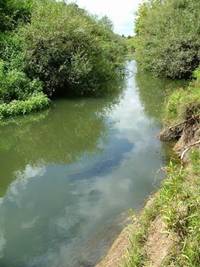Awanui River at Waihue Channel
The lowest of three sites on the Awanui River system it is located directly downstream of the discharge from Kaitaia oxidation ponds and upstream of the Waihue Channel. By the time it reaches this point the Awanui River has flowed through more than 30 km of agricultural land and Kaitaia township. The ‘River Environment Classification' identifies this site as a low elevation river with soft sediment geology and pastoral land use.
The 2005-2006 results for the Awanui River site at Waihue Channel are summarised in the table below including the median, range and percentage of sampling occasions that comply with relevant guidelines for the 12 sampling occasions. Medians shown in red are outside the recommended guidelines.
| Parameter | Median | Range | % comply with guideline |
| Temperature (deg. cel.) | 16.8 | 12 - 22.7 | |
| Dissolved oxygen (mg/L) | 8.2 | 7.3 - 10.2 | 100 |
| Dissolved oxygen (% Sat.) | 85.1 | 72.7 - 108 | 9 |
| Conductivity (mSm) | 20.8 | 16.7 - 22.9 | |
| Water clarity (m) | 0.50 | 0.4 – 1.0 | 30 |
| Turbidity (NTU) | 7.3 | 3.2 - 25 | 18 |
| E. coli (n/100mL) | 323 | 141 - 1860 | 0 |
| Dissolved reactive phosphorus (mg/L) | 0.060 | 0.018 - 0.166 | 0 |
| Total phosphorus (mg/L) | 0.107 | 0.032 - 0.259 | 9 |
| Ammoniacal nitrogen (mg/L) | 0.005 | 0.005 - 0.2 | 64 |
| Total nitrogen (mg/L) | 0.554 | 0.221 - 0.91 | 73 |
| pH | 7.5 | 6.9 - 8.4 | 82 |
 Awanui River.
Awanui River.
This site on the Awanui River is severely impacted. The medians for dissolved oxygen (% saturation), water clarity, turbidity, E. coli, dissolved reactive phosphorus and total phosphorus do not meet their respective guidelines. The particularly concerning results as with many of the other impacted sites in the river network, is the consistently high phosphorus results. The source of this phosphorus is likely to be run-off from pastoral land use within the catchment but the Kaitaia oxidation pond discharge directly upstream could also be a source.
The good news is that the long-term trends for this site suggest that dissolved reactive phosphorus, total phosphorus and ammoniacal nitrogen are declining. However there is also significant trends suggesting pH, conductivity and total kjeldahl nitrogen (organic nitrogen) are increasing.
